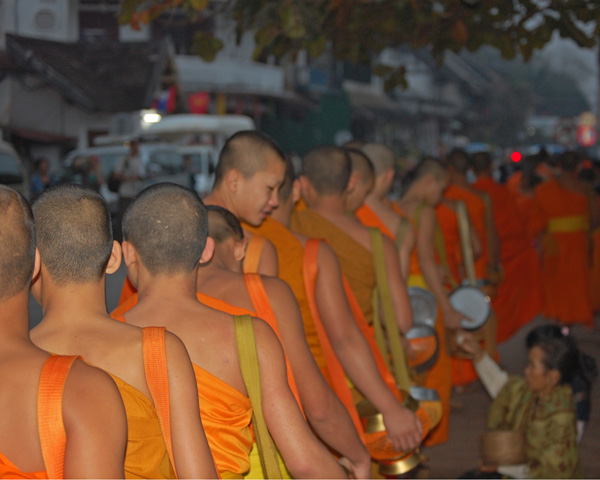During January 2010, religion professor Steven Sacks led a group of students to Southeast Asia for the course Religions of Laos. The course focused on firsthand observations of religious and cultural practices, coupled with interviews, homestays, and other direct interactions with local people.

Homebase was the World Heritage City of Luang Prabang, and side journeys included visits to various indigenous villages in Laos' northern mountains, the ancient temples of Angkor Wat in Cambodia, and boat excursions on the Mekong River.
Student reflections by Tony Immergluck
Why did you choose to go on the trip?
I was particularly drawn to it due to a longstanding personal interest in Southeast Asian Buddhism. And as a student of literature as well as religion, I find that nothing has as profound an impact on creative writing than traveling abroad.
What is Laos like?
Laos is divided, roughly speaking, into a 60 percent Buddhist majority, located mostly in urban areas, and a 40 percent animist minority, which consists of a vast diversity of separate, largely indigenous peoples. The animist societies are spread throughout the mountainous countryside in the north.
What were some highlights of the cities?
The city of Louang Phrabang left a lasting impression on me. The place has such a fragrant personality. It teems with marketplaces, local foods and spirituality. Buddhist sanghas bump against restaurants, art galleries and massage parlors. Monks are a constant, spectral presence in the cities, gliding across the sidewalks discreetly and gracefully. The city is mostly exempt from the type of commercial globalization American tourists are used to. There are no McDonalds, no Starbucks. Everything is so distinctly Lao, and the scenery, mostly along the smoky, snaking Mekong River, is consistently stunning.
Did you visit villages? What was most memorable?
We visited a number of villages and studied their beliefs and practices. We stayed for a few days with the Tai Leu people, splitting up by twos and living, working, and eating with a host family. Despite our initial difficulties [with communication and food], Sam Hedine and I quickly bonded with our family.
The night before we left, we were treated to a uniquely Lao ceremony known as the baci, which serves to connect the spirits of the travelers with those of the villagers. After a short ceremony in which my fellow students and I were situated around an altar, splattered with water, and asked to move our hands in particular reverent gestures, the ritual took a turn for the intimate and spiritual. We were instructed to face a large crowd of villagers, who all, one by one, tied wool threads around each of our wrists.
Scored by a low, reedy chant, the sense of community was overwhelming and humbling. Hands from every angle grabbed at our forearms and gently, usually with a small nod of acceptance, bound us perennially to their way of life. Once our wrists and forearms were weighted down with countless threads, the atmosphere lightened. We shared a generous meal of dung beetles (which we had dug ourselves), grubs, fish, sweet potatoes and stewed wood, while laughing and mingling. I have stayed with indigenous groups before, but I have never encountered such overwhelming kindness and generosity.
Did you do any interviews, projects, reports, etc?
As a matter of fact, the trip was more or less structured around interviews. Many of these were integrated into the framework of our course in order to bridge the gap between what we'd read and what we'd experienced. Through a translator and guide, we spoke with a number of fascinating figures around Louang Phrabang, including the eldest monk of the region and a woman who claimed to have remembered a past life. As we moved into the northern countryside, our focus turned towards the shamans of various animist minorities. Our final project was a paper based on first-person interviews and research, so we were given opportunities to branch off and pursue our personal interests. My research was based on shamans, but other students spoke with people as diverse as nuns, governmental officials and educators.
Did the trip inspire any future plans?
Without a doubt, I plan to continue my studies in Southeast Asia, whether through school or independently.
 Homebase was the World Heritage City of Luang Prabang, and side journeys included visits to various indigenous villages in Laos' northern mountains, the ancient temples of Angkor Wat in Cambodia, and boat excursions on the Mekong River.
Homebase was the World Heritage City of Luang Prabang, and side journeys included visits to various indigenous villages in Laos' northern mountains, the ancient temples of Angkor Wat in Cambodia, and boat excursions on the Mekong River.